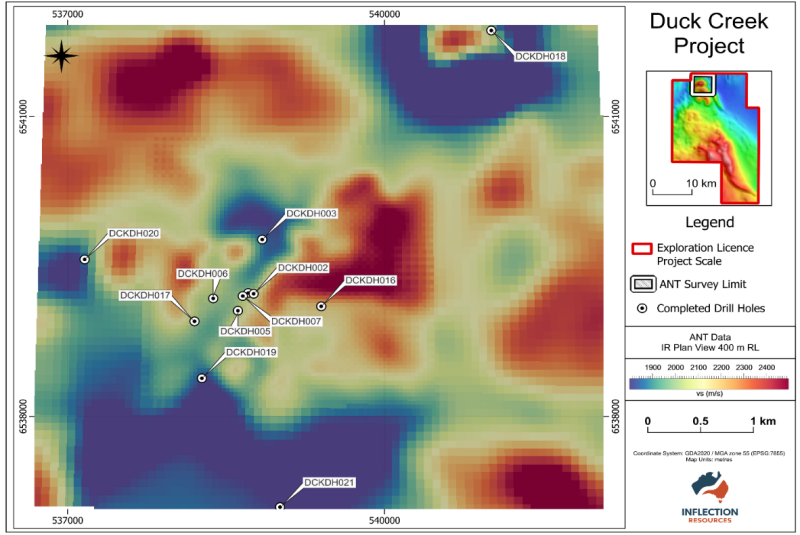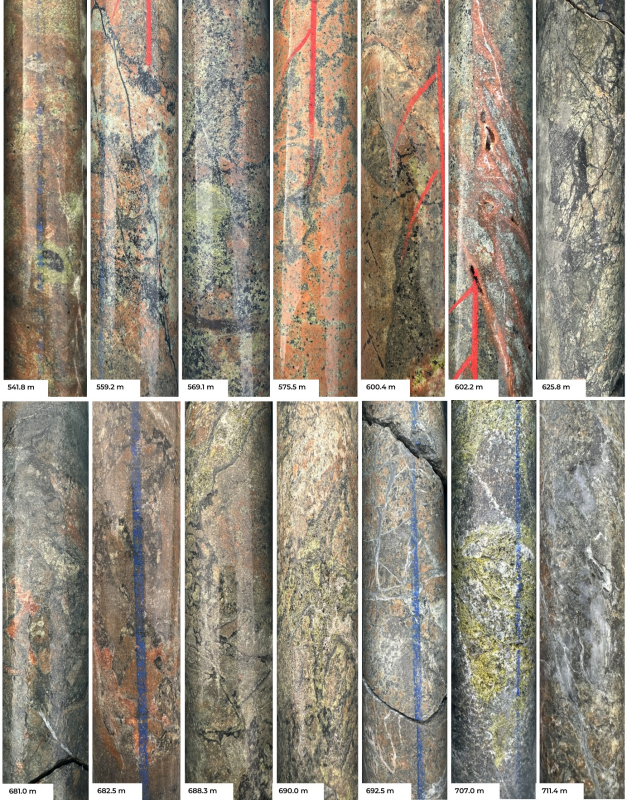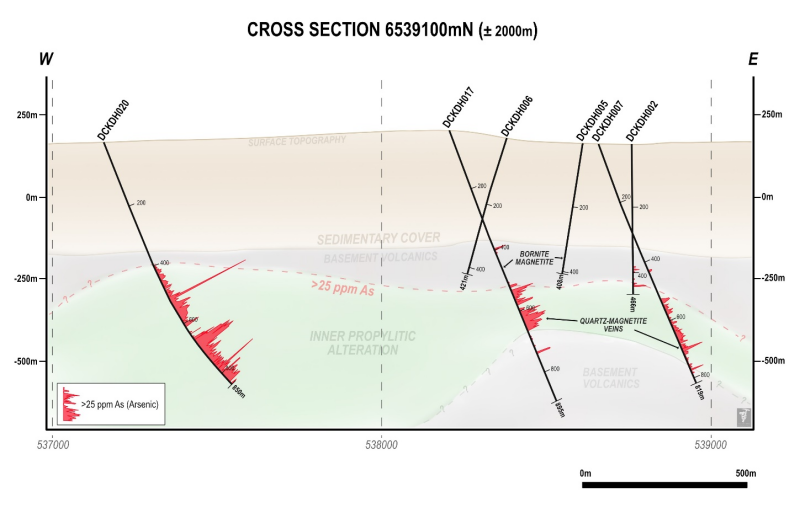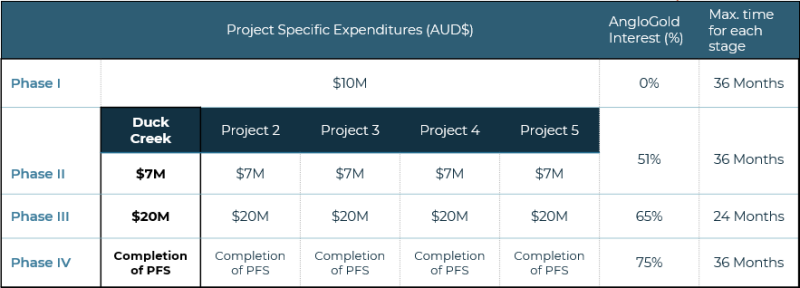(TheNewswire)
Vancouver, British Columbia - TheNewswire - October 3, 2024: Inflection Resources Ltd. (CSE: AUCU / OTCQB: AUCUF / FSE: 5VJ) (the "Company" or "Inflection") is pleased to provide an update on its Phase II exploration program in New South Wales, Australia conducted under an Exploration Agreement with AngloGold Ashanti Australia Limited (“AngloGold Ashanti”) announced on June 14, 2023.
Summary Highlights:
-
Drilling has recommenced on the Phase II Duck Creek project following an 8-week hiatus to compile analytical results and model all data for improved vectoring of drill holes. Prior to the hiatus, four additional deep drill holes totalling 2,822m were completed.
-
Hole DCKDH020 intersected significant magnetite alteration and veinlets along with elevated arsenic geochemical values (40ppm As), which are considered highly significant by the Company as similar levels of anomalism are reported in close proximity to other alkalic porphyry systems in New South Wales and elsewhere.
Alistair Waddell, Inflection’s President and CEO, states: "We are very excited by the intense hydrothermal alteration and sulphide mineralization intersected in drill hole DCKDH020 which is the most intense alteration of all drill holes completed in the entire New South Wales program to-date. We are particularly excited as the hole was designed to test an ANT target that coincides with a distinct magnetic high and broad gravity low which are key features we specifically use for targeting. The intersection of altered monzodiorite intrusions in this hole, along with tourmaline and magnetite veinlets associated with highly anomalous arsenic values is considered very encouraging as these features are often found proximal to other alkalic porphyry systems in New South Wales. We look forward to completing the next round of Phase II drill holes, which are currently stepping out from hole DCKDH020.”
Phase II Drilling:
Four Phase II targets at Duck Creek have been tested with mud rotary drill holes and diamond-core tails for a total of 2,822m to test high and low velocity ANT anomalies and a zone of low Bouguer gravity (Figure 1). Drill hole DCKDH020 was drilled to the east with a dip of -70° to a depth of 850m and tested an approximate 300m x 420m zone of elevated seismic velocity evident in the ANT data interpreted to represent an intrusion at depth (Figure 3). DCKDH020 intersected the strongest hydrothermal alteration of all holes at Duck Creek and the entire New South Wales program since inception. The hole intersected 401m of post-mineral, sedimentary cover sequence followed by basement comprising a thick sequence of variably epidote-chlorite altered andesitic volcanic rocks with hematite-bearing inner propylitic alteration (Figure 2).Intruding the volcanic pile are intensely pyritic, hematite reddened, hornblende-phyric monzodiorites with strong alteration, which implies pre- to syn-alteration timing for intrusion emplacement. Veinlet and disseminated pyrite commonly occur along with disseminated and veinlet magnetite, with epidote and tourmaline often associated with quartz-calcite veins. The association of intense tourmaline alteration combined with disseminated and veinlets of magnetite suggests possible proximity to a porphyry source for the hydrothermal fluids.
Results from a downhole geophysical survey reported zones of relatively high sonic velocity associated with competent intervals of monzodiorite, which supports the hypothesis that intrusions are likely to manifest in the ANT data as zones of elevated seismic velocity. Additionally, the survey demonstrated localised areas of low sonic velocity associated with more intense hydrothermal alteration, which also supports the interpretation that low seismic velocities evident in the ANT survey can represent zones of hydrothermal alteration.
Assay results returned for the hole indicate a broad zone of elevated Cu (max 788ppm) with values generally increasing downhole. Intervals of elevated Au (max 0.051 ppm) and pathfinder elements including Mo (max 29.8ppm), As (max 212ppm) and Bi (max 16.2ppm) suggest fertile hydrothermal fluids. Arsenic values average 43.9ppm over 448.5m from the top of the hole starting at the unconformity to the end of the hole. These values are considered highly anomalous as 200m to 500m from the Cadia Ridgeway ore body (Newmont Corporation) reports arsenic in the 20ppm to 30ppm range and copper in the 200ppm to 300ppm range (A. Wilson, pers. comm.).
Hole DCKDH020 is being followed up with a number of step-out drill holes to explore for a possible porphyry source for the favourable alteration and geochemical data. Drilling is underway.

Click Image To View Full Size
Figure 1: Duck Creek ANT survey plan view at -400m RL, or 570m below surface, with drill holes and showing zones of low (blue colours) and high (yellow to red colours) seismic velocity interpreted as targets for hydrothermal alteration and intrusions respectively.

Click Image To View Full Size
Figure 2: Select photos of DCKDH020 drill core. Inner propylitic alteration with variably epidote-chlorite altered, highly pyritic andesitic, brecciated volcanic rocks and hematite reddened hornblende-phyric monzodiorite with tourmaline and magnetite. The association of intense tourmaline alteration and magnetite veinlets suggests proximity to a porphyry source for the hydrothermal fluids.

Click Image To View Full Size
Figure 3: Cross section showing hole DCKDH020 relative to other Duck Creek holes with arsenic values.
Drill hole DCKDH018 was drilled to a depth of 740m to test a discreet, finger-like zone of elevated seismic velocity evident in the ANT data. The hole was drilled at a dip of -70º toward 295º and intersected basement at 431m which comprised an intercalated sequence of volcaniclastic sediments with andesites. The sequence exhibits weak chlorite alteration and does not satisfactorily explain the feature identified in the ANT data. The Company is working to better understand the ANT anomaly although the specific target has been downgraded. Assay results for this hole reported low tenor values.
Drill hole DCKDH019 was drilled to a depth of 564m at a dip of -70º toward 264º to test a north-east trending zone of reduced seismic velocity evident in the ANT data. The ANT target was interpreted to be indicative of alteration associated with a large fault zone. The hole intersected basement at 398m which comprised volcaniclastic conglomerate and andesite intruded by monzonite intrusions. These are locally cut by sericite-carbonate bearing fault zones which appear in the ANT data as linear seismic velocity lows. No significant mineralization was intersected and assay results reported low tenor values.
Drill hole DCKDH021 was drilled to a depth of 666m at a dip of -70º toward 180º to test a north-east trending gravity low, interpreted to represent an intrusion at depth. The hole intersected basement rocks at 407m which comprise an intercalated sequence of volcaniclastic conglomerate with andesite, intruded by small monzonite dykes. The hole did not intersect a large intrusion as modelled, which would have explained the gravity low. It is now postulated that this gravity low is the manifestation of a larger batholith at depth, which is bleeding off smaller intrusive dykes. The hole reported low tenor values.
Phase II Duck Creek Exploration Program:
AngloGold Ashanti elected to designate the Company’s Duck Creek Exploration License as a Phase II Project as part of the Exploration Agreement announced on June 14, 2023.
As part of Phase II at Duck Creek, AngloGold Ashanti retains the right to earn an initial 51% interest in the project by investing AUD$7,000,000 in exploration expenditures (Table 1). Upon completion of Phase II, AngloGold Ashanti retains the additional right, as part of a Phase III program, to earn up to a 65% interest by investing a further AUD$20,000,000 in expenditures. Upon completion of Phase III, AngloGold Ashanti retains the right to earn up to a 75% interest by completing a pre-feasibility study with a minimum two-million-ounce gold or copper-gold equivalent resource (Measured & Indicated category) and ceding a 2% or 1% net smelter return (“NSR”) royalty to Inflection. Inflection is operating Phases I and II and is receiving a 10% management fee for doing so. See Inflection news release dated June 14, 2023 for further details.

Click Image To View Full Size
Table 1: Table outlining the principal financial terms of the AngloGold Ashanti Exploration Agreement.
PFS = Pre-Feasibility Study.
Qualified Person and Sampling Quality Control:
The scientific and technical information contained in this news release has been reviewed and approved by Mr. Carl Swensson (FAusIMM), a “Qualified Person” (“QP”) as defined in National Instrument 43-101 – Standards of Disclosure for Mineral Projects.
Drilling is being conducted using a truck-mounted multi-purpose drill rig. Mud rotary drilling is utilised to drill through the cover sequence before transitioning to diamond drilling using NQ sized core at the unconformity. Core is logged at the Company’s field office, photographed and marked before being cut to the Company’s specified sample intervals. Half core samples are placed in bags with internationally certified blanks and standards inserted. Samples are dispatched to ALS Laboratories in Orange NSW, an accredited analytical laboratory meeting ISO/IEC 17025:2005 and ISO 9001:2015. Samples are prepared by crushing and grinding via ALS methods CRU-21 and PUL-32 respectively. The pulps are then assayed for 48 elements via ALS method ME-MS61 using a 25g sample after a four acid near total digest with an ICP-MS finish. Gold is assayed by fire assay using ALS method Au-AA23 using a 30g sample charge and AAS finish. Laboratory standards and QA-QC are monitored by the Company. Coarse rejects from the sample preparation are subjected to spectral analysis.
About Inflection’s NSW Projects:
The Company is systematically exploring for large copper-gold deposits in the northern interpreted extension of the Macquarie Arc, part of the Lachlan Fold Belt in New South Wales. The Macquarie Arc is Australia’s premier porphyry copper-gold province host to Newmont’s Cadia deposits, Evolution Mining’s Cowal and Northparkes deposits plus numerous exploration prospects including Boda, the discovery made by Alkane Resources.
The Company uses cost-effective mud-rotary drilling to cut through unmineralized post-mineral sedimentary cover before transitioning to diamond core drilling once the prospective basement is reached. It is well documented that mineralized bodies elsewhere in the belt, in particular porphyry and intrusive related systems have large district-scale alteration and geochemical halos or footprints surrounding them. The Company typically completes a series of short diamond drill holes into the basement bedrock with multiple data points gained from alteration and mineral geochemistry which is then used to vector additional deeper holes. This is a proven exploration methodology in the covered segments of the Macquarie Arc having been directly responsible for the discovery of the Northparkes and Cowal deposits.
About Inflection Resources Ltd.Inflection is a technically driven copper-gold focused mineral exploration company listed on the Canadian Securities Exchange under the symbol “AUCU”, on the OTCQB under the symbol “AUCUF” and on the Frankfurt Stock Exchange under the symbol “5FJ”, with projects in New South Wales, Australia. For more information, please visit the Company website at www.inflectionresources.com.
Inflection is part of the NewQuest Capital Group which is an entrepreneurial, discovery-driven investment group that builds value through the incubation and financing of early-stage mineral exploration projects globally. Further information about NewQuest can be found at www.nqcapitalgroup.com
On behalf of the Board of Directors:
Alistair Waddell
President and CEO
alistair@inflectionresources.com
For further information, please contact:
Brennan Zerb
Investor Relations Manager
+1 (778) 867-5016
bzerb@inflectionresources.com
Forward-Looking Statements: This news release includes certain forward-looking statements and forward-looking information (collectively, "forward-looking statements") within the meaning of applicable Canadian securities legislation. All statements, other than statements of historical fact, included herein including, without limitation, statements regarding future capital expenditures, amount of drilling, receipt of the maximum amount of available grant funding, anticipated content, commencement and cost of exploration programs in respect of the Company's projects and mineral properties, AngloGold’s anticipated funding of the Minimum Commitment and timing thereof, and the anticipated business plans and timing of future activities of the Company, are forward-looking statements. Although the Company believes that such statements are reasonable, it can give no assurance that such expectations will prove to be correct. Often, but not always, forward looking information can be identified by words such as "pro forma", "plans", "expects", "may", "should", "budget", "scheduled", "estimates", "forecasts", "intends", "anticipates", "believes", "potential" or variations of such words including negative variations thereof, and phrases that refer to certain actions, events or results that may, could, would, might or will occur or be taken or achieved. Forward-looking statements involve known and unknown risks, uncertainties and other factors which may cause the actual results, performance or achievements of the Company to differ materially from any future results, performance or achievements expressed or implied by the forward-looking statements. Such risks and other factors include, among others, statements as to the anticipated business plans and timing of future activities of the Company, including the Company's exploration plans. the proposed expenditures for exploration work thereon, the ability of the Company to obtain sufficient financing to fund its business activities and plans, delays in obtaining governmental and regulatory approvals (including of the Canadian Securities Exchange), permits or financing, changes in laws, regulations and policies affecting mining operations, the Company's limited operating history, currency fluctuations, title disputes or claims, environmental issues and liabilities, as well as those factors discussed under the heading "Risk Factors" in the Company's prospectus dated June 12, 2020 and other filings of the Company with the Canadian Securities Authorities, copies of which can be found under the Company's profile on the SEDAR website at www.sedar.com.Readers are cautioned not to place undue reliance on forward-looking statements. The Company undertakes no obligation to update any of the forward-looking statements, except as otherwise required by law.
Copyright (c) 2024 TheNewswire - All rights reserved.